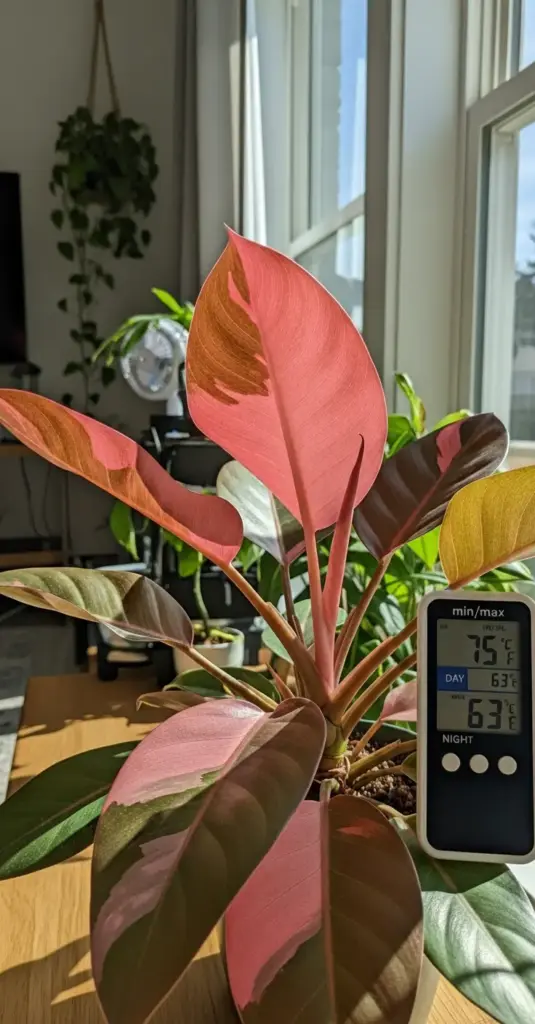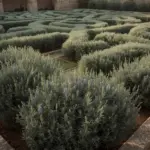7. The Temperature Trick That Intensifies Pink Coloration

This temperature hack literally transformed my Pink Princess from producing pale, washed-out variegation to deep, vibrant pink that makes people stop and stare. I discovered this completely by accident when I moved my plant to a different room.
The science behind this blew my mind, and the best part? It costs absolutely nothing to implement.
The Cool Night Secret That Changes Everything
Pink Princess produces the most intense coloration when nighttime temperatures drop 10-15 degrees below daytime temps. This mimics their natural tropical environment where nights are significantly cooler.
I stumbled onto this when my plant spent a week near a drafty window during a cold snap. Instead of suffering, the new leaves emerged with the deepest pink I’d ever seen.
The temperature fluctuation triggers the plant to produce more anthocyanins – the pigments responsible for pink and red coloration. It’s like the plant thinks winter is coming and ramps up its protective pigments.
Most people keep their plants at constant temperatures, which actually works against maximum variegation. Your Pink Princess needs those cool nights to really shine.
Creating Natural Temperature Zones in Your Home
Every house has natural temperature variations that you can use to your advantage. I mapped my home’s temperature zones using a simple digital thermometer.
My living room stays around 72°F during the day but drops to 65°F at night near the exterior wall. This 7-degree difference was already helping my plant, but I wanted more.
I moved my Pink Princess to a spot that gets warm afternoon sun but sits near a window that cools down at night. The temperature swing increased to 12 degrees, and the results were incredible.
Basements, north-facing rooms, and areas near exterior walls naturally have more temperature variation than central, interior spaces.
My Exact Temperature Strategy
During growing season, I aim for 75-78°F days and 62-65°F nights. This 10-15 degree difference is the sweet spot for maximum pink production.
I use a small fan on a timer to create gentle air circulation that helps with the natural cooling process. The fan runs from 10 PM to 6 AM on the lowest setting.
In winter, I actually move my plant closer to windows where it experiences more temperature variation. The slight stress from cooler nights triggers better variegation without harming the plant.
I track temperatures with a min/max thermometer that records daily highs and lows. This data helps me fine-tune placement for optimal temperature swings.
The Surprising Science Behind Cool Nights
Cooler nighttime temperatures slow down chlorophyll production while maintaining anthocyanin levels, resulting in more prominent pink coloration.
Think of it like a natural photo development process – the cool nights allow the pink pigments to intensify while reducing the green competition.
This is why Pink Princess plants grown in greenhouses with controlled temperatures often have less vibrant variegation than those experiencing natural temperature fluctuations.
The plant interprets temperature drops as environmental stress and responds by producing protective pigments that happen to be the beautiful pink we love.
Using Your Home’s Natural Temperature Zones
Rooms with large windows experience the most natural temperature variation – they heat up during the day and cool down at night following outdoor temperature patterns.
I identified three perfect spots in my house: near the patio door in my living room, by the bedroom window that faces north, and in my sunroom that gets hot during the day but cools significantly at night.
Avoid interior rooms with no exterior walls – these maintain the most consistent temperatures, which works against variegation enhancement.
Bathrooms can work well if they have windows and don’t stay constantly humid from shower use. The temperature swings plus humidity can create ideal conditions.
Protecting Your Plant During Extreme Weather
Never let nighttime temperatures drop below 55°F – this crosses the line from beneficial stress to harmful cold damage. I learned this during an unexpected cold snap.
During heat waves, I move my plant away from windows that get scorching afternoon sun. Temperatures above 85°F can cause heat stress and fade variegation.
I use sheer curtains to filter intense sunlight while still allowing temperature fluctuations. The goal is temperature variation, not temperature extremes that can damage the plant.
Winter heating can create too much temperature consistency. I actually turn down my thermostat slightly at night to encourage natural cooling.
Reading Temperature Stress Signals
Beneficial temperature stress shows up as intensified pink coloration in new growth within 2-3 weeks of implementing temperature fluctuations.
Harmful cold stress appears as brown leaf edges, yellowing, or stunted growth. If you see these signs, your nighttime temperatures are dropping too low.
Heat stress manifests as wilting during the day even when soil is moist, or faded, washed-out variegation. Move the plant to a cooler location immediately if you notice these symptoms.
The sweet spot produces vibrant pink new growth with healthy, firm leaf texture and consistent growth patterns.
Seasonal Temperature Adjustments
Spring and summer are prime time for temperature manipulation when the plant is actively growing and can respond quickly to environmental changes.
Fall temperature swings often produce the most dramatic variegation as the plant prepares for winter dormancy. I take advantage of natural seasonal cooling.
Winter requires more careful monitoring since indoor heating can eliminate beneficial temperature variation. I use programmable thermostats to create artificial day/night cycles.
During summer heat waves, I focus more on protecting from excessive heat than creating temperature swings.
The Equipment That Makes It Easy
A simple min/max thermometer costs $10 and tells you everything you need to know about your plant’s temperature environment. I check it daily during growing season.
Programmable fans on timers help create air circulation that enhances natural cooling. I use basic desk fans from thrift stores – nothing fancy required.
For extreme situations, I have a small space heater and a portable AC unit that I can use to fine-tune temperatures. But honestly, most homes have natural zones that work perfectly without additional equipment.
Thermal curtains can help maintain temperature swings by insulating windows during the day and allowing cooling at night.
The Results That Shocked Everyone
After implementing strategic temperature fluctuations, my Pink Princess started producing leaves with 60-80% pink variegation compared to the 30-40% I was getting before.
The pink coloration became deeper and more vibrant – almost burgundy in some sections. People started asking if I was using special fertilizers or grow lights.
New growth emerged more consistently, and the overall plant health improved dramatically. The slight temperature stress seemed to invigorate the entire plant’s growth patterns.
I also noticed that propagated cuttings rooted faster and maintained better variegation when exposed to temperature fluctuations during the rooting process.
Common Temperature Mistakes That Backfire
Placing plants directly against cold windows can cause localized cold damage even when room temperatures are fine. Leave a few inches of buffer space.
Using heating pads or heat mats eliminates the beneficial temperature variation that triggers pink production. Constant warmth actually reduces variegation.
Another mistake: moving plants too frequently to chase temperature zones. Pick a good spot and let the plant adjust rather than constantly relocating it.
And never use ice cubes or cold water to create artificial temperature drops. This shocks the root system and can cause serious damage.
Advanced Temperature Techniques
I track outdoor temperature patterns and adjust my plant’s location seasonally to take advantage of natural cooling and warming cycles.
During mild weather, I actually move my Pink Princess outside overnight to experience natural temperature fluctuations. The results are incredible, but this requires careful monitoring.
For serious collectors, a greenhouse with day/night temperature controls allows precise manipulation of temperature swings for maximum variegation.
I also group my aroids together in temperature zones – plants with similar needs get placed in areas with appropriate temperature patterns.
Conclusion
These seven underground care hacks have completely revolutionized how I approach Pink Princess care, and I know they’ll do the same for you!
Remember, growing a stunning Pink Princess isn’t about expensive equipment or complicated routines – it’s about understanding what your plant truly needs.
Start with just one or two of these techniques and gradually incorporate the others as you see results. Your Pink Princess will reward you with those gorgeous pink leaves that make every plant parent’s heart skip a beat!
Which hack are you most excited to try first?
Drop a comment below and let me know how these secrets work for your plant baby!









GIPHY App Key not set. Please check settings